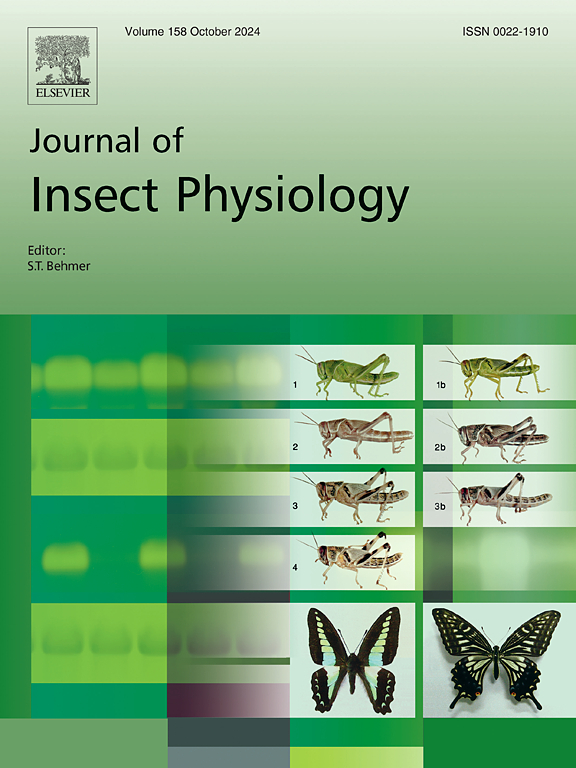The flavouring agent, 2-octenoic acid kills Galleria mellonella (Lepidoptera: Pyralidae) by affecting their immunocompetent cells and cuticular FFA profiles
IF 2.3
2区 农林科学
Q1 ENTOMOLOGY
引用次数: 0
Abstract
This study investigates the effects of the naturally occurring flavouring agent, trans-2-octenoic acid, on the insect model Galleria mellonella by examining its impact on immunocompetent cells and free fatty acid (FFA) profiles in the cuticle. The value of LD50 for 2-octenoic acid has been calculated as 9.66 µg/mg of insect body mass, this value is outside the GHS scale, indicating that the compound is unlikely to cause acute toxicity after dermal application and is safe for humans and mammals. The treatment with 2-octenoic acid caused several changes in the insect defence mechanismes, viz. changes in cuticular FFA profiles and death of immunocompetent cells. In larvae, topical treatment of 2-octenoic acid increased the concentration of cuticular FFAs, particularly C6:0 (245 times higher), C15:0 (110 times higher), and C16:1 (1608 times higher), and 2-octenoic acid (C8:1) accumulated significantly on the surface of the cuticle. In adults, treatment resulted in lower cuticular C8:1concentrations than in larvae, which might indicate that 2-octenoic acid penetrates more effectively through the adult cuticle. The 2-octenoic acid application demonstrated considerable cytotoxicity against insect cell line Sf9 and G. mellonella hemocytes, with both in vivo and in vitro treatment. Our findings contribute to the broader understanding of how synthetic and naturally occurring chemicals may interact with the immune and physiological systems of insects, particularly focusing on G. mellonella as a model organism for toxicological studies. Given the increasing interest in the ecological and physiological impacts of food additives, our research provides novel insights into the biological interactions of 2-octenoic acid and its potential role as an insecticide.

风味剂2-辛烯酸通过影响其免疫能力细胞和表皮FFA谱来杀死mellonella(鳞翅目:Pyralidae)
本研究通过检测其对免疫能力细胞和角质层中游离脂肪酸(FFA)谱的影响,研究了天然存在的调味剂反式-2-辛烯酸对昆虫模型mellonella的影响。经计算,2-辛烯酸的LD50值为9.66µg/mg昆虫体重,该值超出GHS标准,表明该化合物经皮肤施用后不太可能引起急性毒性,对人类和哺乳动物是安全的。2-辛烯酸处理引起了昆虫防御机制的一些变化,即表皮FFA谱的变化和免疫活性细胞的死亡。2-辛烯酸局部处理使表皮FFAs浓度显著升高,其中C6:0(升高245倍)、C15:0(升高110倍)和C16:1(升高1608倍)浓度最高,2-辛烯酸(C8:1)在表皮表面积累显著。在成虫中,处理后的c8:1浓度低于幼虫,这可能表明2-辛烯酸通过成虫角质层的渗透更有效。在体内和体外处理下,2-辛烯酸应用对昆虫细胞系Sf9和mellonella血细胞显示出相当大的细胞毒性。我们的发现有助于更广泛地了解合成和自然发生的化学物质如何与昆虫的免疫和生理系统相互作用,特别是关注大蜡杆菌作为毒理学研究的模式生物。鉴于人们对食品添加剂的生态和生理影响越来越感兴趣,我们的研究为2-辛烯酸的生物相互作用及其作为杀虫剂的潜在作用提供了新的见解。
本文章由计算机程序翻译,如有差异,请以英文原文为准。
求助全文
约1分钟内获得全文
求助全文
来源期刊

Journal of insect physiology
生物-昆虫学
CiteScore
4.50
自引率
4.50%
发文量
77
审稿时长
57 days
期刊介绍:
All aspects of insect physiology are published in this journal which will also accept papers on the physiology of other arthropods, if the referees consider the work to be of general interest. The coverage includes endocrinology (in relation to moulting, reproduction and metabolism), pheromones, neurobiology (cellular, integrative and developmental), physiological pharmacology, nutrition (food selection, digestion and absorption), homeostasis, excretion, reproduction and behaviour. Papers covering functional genomics and molecular approaches to physiological problems will also be included. Communications on structure and applied entomology can be published if the subject matter has an explicit bearing on the physiology of arthropods. Review articles and novel method papers are also welcomed.
 求助内容:
求助内容: 应助结果提醒方式:
应助结果提醒方式:


